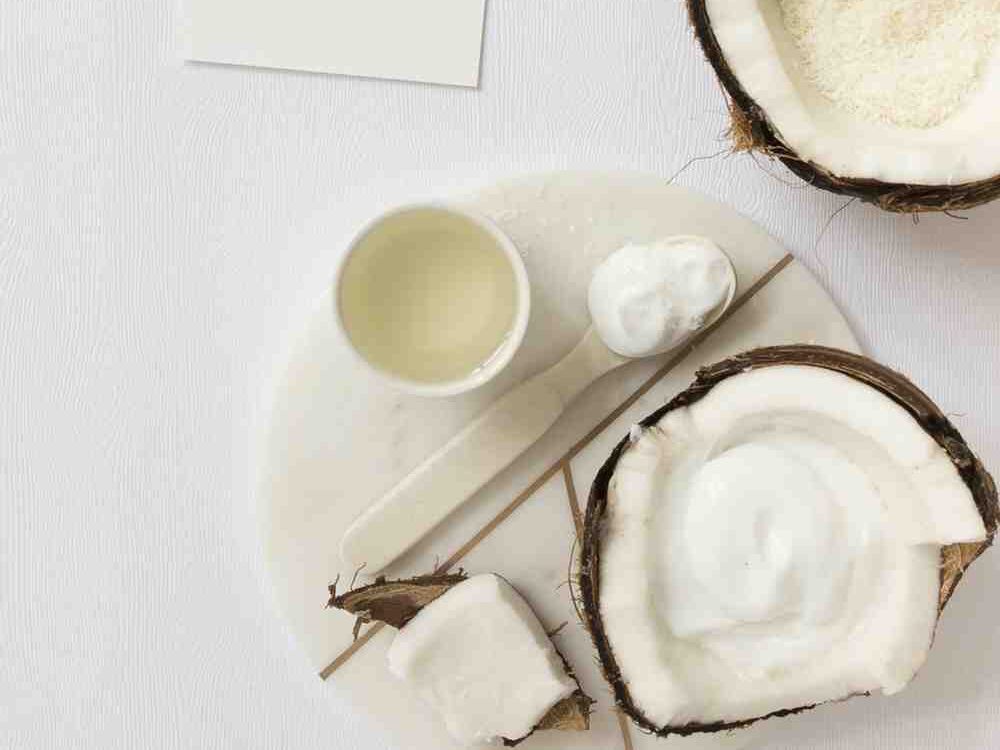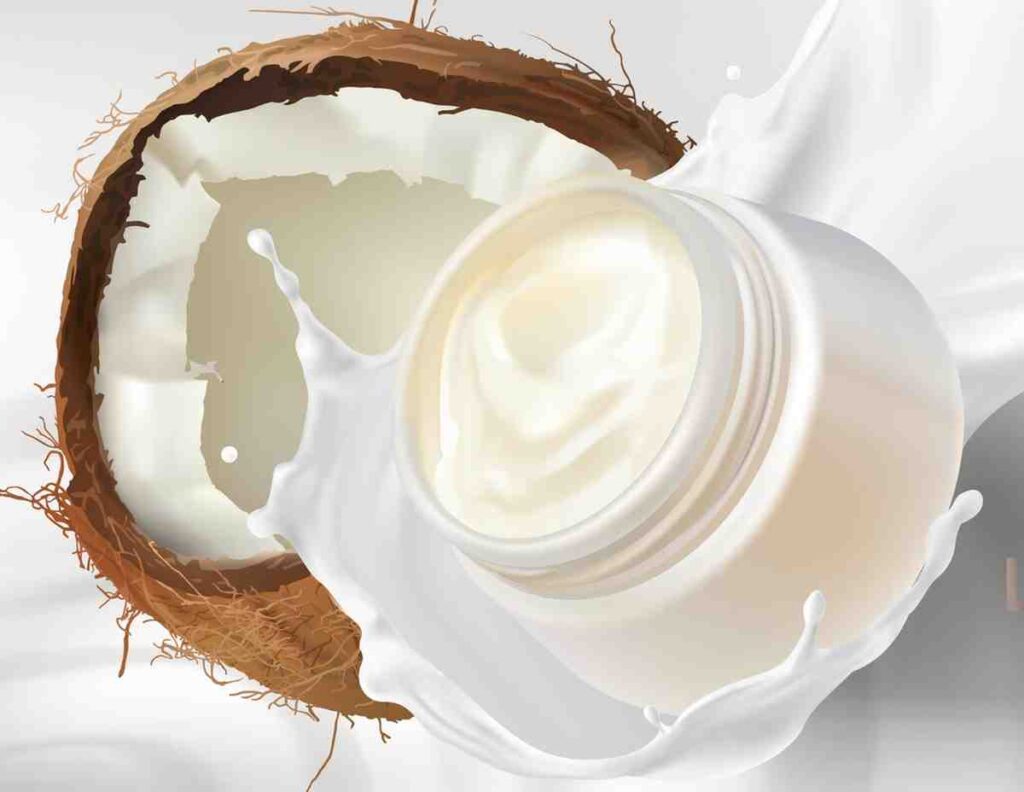Coconut cream has gained popularity as a go-to ingredient for those seeking a dairy-free option. Its thick, rich texture makes it perfect for a wide variety of dishes, from desserts to savory meals. Whether you’re looking to replace dairy or simply want to add a tropical flair to your cooking, coconut cream offers a flavorful and nutritious solution.
The Origins of Coconut Cream
Coconut cream originates from tropical regions where coconuts are abundant. In places like Southeast Asia, the Caribbean, and South America, coconut cream plays a key role in many traditional dishes. Unlike coconut milk, which has a lighter consistency, coconut cream is extracted from the grated meat of mature coconuts, offering a thicker, richer product.
How Coconut Cream is Made
- Extracting Coconut Cream: Coconut cream is made by pressing the grated flesh of mature coconuts, producing a thick liquid with a high-fat content.
- Difference from Coconut Milk: Coconut milk, a thinner liquid, comes from adding water to coconut flesh. Coconut cream, however, is the result of minimal dilution, making it thicker and richer.
- Commercial Availability: You can find coconut cream in most grocery stores, either canned or in concentrated form, making it convenient for use in cooking.

Nutritional Benefits of Coconut Cream
Coconut cream isn’t just delicious; it also offers a variety of health benefits. Its high fat content, particularly medium-chain triglycerides (MCTs), makes it a source of quick energy. These MCTs are metabolized differently from other fats, which helps your body convert them into energy rather than store them as fat.
Nutritional Highlights
- Rich in MCTs: The healthy fats in coconut cream, specifically MCTs, are absorbed quickly by the body and can provide an immediate energy boost.
- Vitamins and Minerals: Coconut cream contains important nutrients like iron, potassium, and magnesium, which contribute to overall health.
- Immune Support: Lauric acid, a component of coconut cream, has antimicrobial properties that help support the immune system.
- Heart Health: While it’s rich in fat, coconut cream’s MCTs may help raise HDL (good) cholesterol levels, which can support heart health.
Weight Management
Coconut cream’s MCT content may actually aid in weight management. Since these fats are used by the body for energy, they are less likely to be stored as fat. Moreover, coconut cream’s richness helps control appetite by promoting satiety.
- Boosts Metabolism: MCTs can increase your metabolic rate, allowing you to burn calories more efficiently.
- Filling and Satisfying: The richness of coconut cream makes you feel full longer, helping to reduce unnecessary snacking.
How to Make Coconut Cream at Home
Making coconut cream at home is straightforward and allows you to control the quality and ingredients. This DIY option ensures that your coconut cream is free from preservatives and additives commonly found in store-bought versions.
Steps for Homemade Coconut Cream
- Gather Ingredients: Start with 2 cups of unsweetened, shredded coconut and 1 cup of hot water.
- Blend: Place the coconut and hot water in a blender, then blend until smooth.
- Strain: Use a nut milk bag or cheesecloth to strain out the coconut pulp, leaving behind the rich coconut cream.
- Store: Transfer the coconut cream to an airtight container and refrigerate for up to 5 days.
Adjusting Consistency
- Thicker Cream: Reduce the amount of water used when blending to achieve a thicker, more concentrated cream.
- Lighter Cream: Add more water for a thinner consistency, making it easier to pour or mix into recipes.
Culinary Uses of Coconut Cream
Coconut cream’s versatility makes it a fantastic ingredient for both sweet and savory dishes. Its natural sweetness pairs well with desserts, while its richness enhances the flavors of savory meals.
Coconut Cream in Desserts
In desserts, coconut cream brings a luxurious texture that’s hard to match with other dairy-free alternatives. Its natural creaminess makes it perfect for whipping, freezing, or adding to baked goods.
- Whipped Topping: Whip coconut cream with a bit of sugar or vanilla for a dairy-free topping that works well on pies, cakes, or hot drinks.
- Ice Cream: Coconut cream serves as a creamy base for homemade ice creams and sorbets, offering smoothness without the use of dairy.
- Puddings and Custards: Incorporate coconut cream into puddings or custards to give them a rich, velvety texture.
Coconut Cream in Savory Dishes
Coconut cream isn’t limited to sweets; it adds richness and depth to savory dishes as well. Its thick consistency makes it an excellent substitute for dairy cream in recipes like curries, soups, and sauces.
- Curries: Coconut cream is a staple in Thai and Indian curries, providing a rich base that balances spices and enhances the overall flavor.
- Soups: Add coconut cream to soups like pumpkin, sweet potato, or butternut squash for a creamy finish without dairy.
- Dips and Sauces: Use coconut cream as a base for creamy dips or dairy-free Alfredo sauces, adding richness and depth to your dishes.

Coconut Cream vs. Other Dairy-Free Alternatives
Coconut cream stands out among other dairy-free alternatives because of its thick texture and unique flavor. While almond and cashew creams are also popular, coconut cream’s versatility and richness make it ideal for specific recipes.
Coconut Cream vs. Almond Cream
- Flavor: Coconut cream has a pronounced coconut flavor, which works well in tropical or sweet dishes, while almond cream has a more neutral taste.
- Fat Content: Coconut cream is higher in fat, providing a richer texture, whereas almond cream is lower in calories and fat.
- Best Uses: Coconut cream excels in dishes where richness is key, like curries and desserts, while almond cream is ideal for lighter, more delicate recipes.
Coconut Cream vs. Cashew Cream
- Texture: Cashew cream is thick and rich, similar to coconut cream, but has a more neutral flavor, making it better suited for savory sauces.
- Nutritional Differences: Coconut cream offers more MCTs, while cashew cream is rich in healthy monounsaturated fats.
- Versatility: Coconut cream works in both sweet and savory dishes, but cashew cream is often preferred for ultra-creamy sauces and dips.
How to Store Coconut Cream
To maintain its freshness, coconut cream should be stored properly. Whether you make it at home or buy it from the store, proper storage is essential to preserving its texture and flavor.
Storing Coconut Cream
- Refrigerate: Store coconut cream in an airtight container in the refrigerator, where it will thicken as it cools. It can last up to 5 days.
- Freeze for Longer Storage: Coconut cream can be frozen in ice cube trays and used as needed. Thaw it in the fridge before using, and give it a good stir to restore its creamy texture.
- Shake or Stir: Coconut cream may separate over time, so always stir or shake it before using to maintain a smooth consistency.
Coconut Cream for Different Diets
Coconut cream fits into many dietary plans. Its high fat and low carbohydrate content make it ideal for those following specific nutrition programs.
Vegan and Plant-Based Diets
For those following vegan diets, coconut cream is a great substitute for dairy. It adds creaminess to recipes without using animal products.
- Dairy-Free: Coconut cream works well in vegan sauces, soups, and desserts.
- Natural Choice: Because it comes from plants, coconut cream supports ethical and sustainable farming practices.
Ketogenic and Low-Carb Diets
Coconut cream suits ketogenic and low-carb diets due to its healthy fats. These fats, known as medium-chain triglycerides (MCTs), provide quick energy and support ketosis.
- High Fat Content: Coconut cream’s MCTs help fuel the body during ketosis.
- Filling and Satisfying: Its rich texture promotes fullness, helping control hunger.
Lactose-Free and Paleo Diets
Coconut cream is naturally lactose-free, making it a top choice for people who cannot digest dairy. It also meets paleo diet guidelines, which focus on whole, unprocessed foods.
- Lactose-Free: Coconut cream provides all the creaminess of dairy without causing digestive discomfort.
- Paleo-Friendly: As a natural product, coconut cream fits well into the paleo lifestyle.
Coconut Cream vs. Other Plant-Based Creams
While coconut cream is versatile, several other plant-based creams also offer healthy alternatives. Let’s compare coconut cream with almond and soy cream.
Coconut Cream vs. Almond Cream
- Flavor: Coconut cream has a tropical flavor that enhances desserts and savory dishes. Almond cream has a milder taste, making it ideal for lighter recipes.
- Nutritional Content: Coconut cream is higher in fat, while almond cream is lower in calories and fat.
- Best Use: Coconut cream works best in curries and rich desserts. Almond cream fits better in soups and salads.
Coconut Cream vs. Soy Cream
- Allergy Considerations: Soy cream may not suit people with soy allergies. Coconut cream is free from most common allergens.
- Texture: Coconut cream tends to be thicker, while soy cream has a lighter consistency.
- Nutritional Benefits: Coconut cream contains more MCTs, while soy cream offers a lower-fat option.
Health Benefits of Coconut Cream
Coconut cream provides more than just a rich flavor. Its unique nutrients offer multiple health benefits.
Boosts Energy and Metabolism
MCTs in coconut cream give the body an immediate energy boost. They are absorbed and converted into energy quickly, helping support metabolism.
- Quick Energy: MCTs fuel the body without being stored as fat.
- Improves Metabolism: Coconut cream can help increase the number of calories your body burns.

Supports Heart Health
Though coconut cream is high in fat, the fats it contains may benefit heart health. MCTs raise HDL (good) cholesterol levels, which may reduce the risk of heart disease.
- Raises Good Cholesterol: Coconut cream helps improve cholesterol balance.
- Anti-Inflammatory: Lauric acid, found in coconut cream, reduces inflammation, supporting heart health.
Immune and Digestive Health
Coconut cream contains lauric acid, which has antimicrobial properties. This fatty acid helps protect against harmful pathogens and promotes a healthy immune system.
- Boosts Immunity: Lauric acid fights bacteria, viruses, and fungi.
- Aids Digestion: Coconut cream improves the absorption of fat-soluble vitamins, supporting digestive health.
Coconut Cream in Beauty and Skincare
Coconut cream also provides benefits outside the kitchen. Its moisturizing properties make it a popular ingredient in skincare and haircare.
Skin Benefits
Coconut cream hydrates and nourishes the skin. Its natural fats lock in moisture, keeping skin soft and smooth.
- Moisturizing: Coconut cream helps retain moisture, leaving skin supple.
- Soothes Irritation: Anti-inflammatory properties calm inflamed or sensitive skin.
Hair Benefits
When used as a hair treatment, coconut cream restores shine and softness. It conditions hair, leaving it smooth and manageable.
- Deep Conditioner: Coconut cream repairs and strengthens hair, reducing frizz.
- Restores Shine: Regular use adds moisture and shine to dry hair.
How to Use Coconut Cream in Your Beauty Routine
Incorporating coconut cream into your beauty routine is easy and offers multiple benefits for both skin and hair. Here are a few ways to use it:
- Face Mask: Mix coconut cream with honey and apply it to your face for 10 minutes. It moisturizes and leaves your skin glowing.
- Hair Mask: Apply coconut cream to damp hair and leave it on for 20 minutes before rinsing. It will deeply condition and soften your hair.
- Body Lotion: Blend coconut cream with essential oils to create a natural, moisturizing lotion for your skin.

